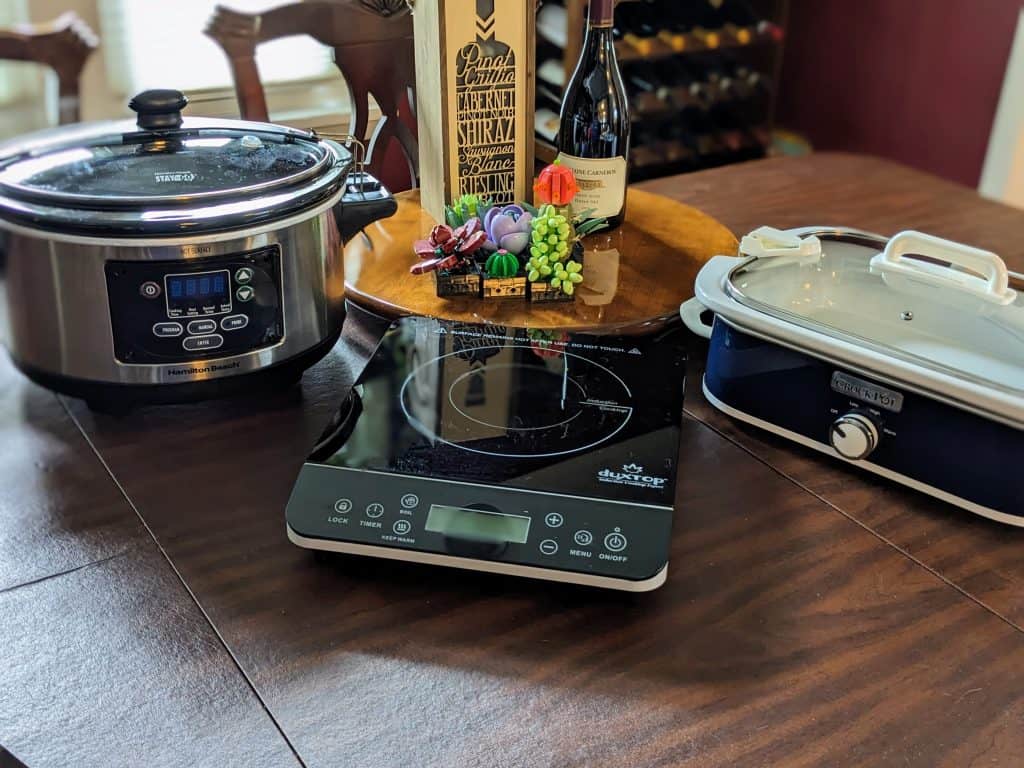The Common Problem of Unintentionally Cooled Food
The Scenario
You’ve done it! You’re on top of things and ready for your dinner party guests.
- Prepared a delicious menu. Check.
- Created an eye-catching table and serving display. Check.
- Planned out your paired wine and/or cocktails. Check. And you even pre-set the wine glasses with charms and decanted the wine you’re serving with dinner. Awesome.
- Got your house “enough” in order for guests. All good. Any unsanctioned doors have been closed.
When the guests arrive, you welcome them in, get them a drink, and start them off with some appetizers. You’ve planned all of your cooking so that you can hang out with your guests when they get there and aren’t tied to the kitchen. Everyone is having a good time. More appetizers are consumed. It’s time to move on to the main meal. Suddenly, you glance up at the clock and realize that the dinner food has been ready and sitting there for an hour.
You gracefully excuse yourself and move with alacrity to the kitchen to check on the food. The side dishes have cooled. The bubbly cheese topping that you had to restrain yourself from tasting has solidified into a solid shell. Worst of all, the fantastic sauce that you made to accompany the main course has developed a bit of a skin. You deflate. While you know that the food will still taste “fine,” you’re annoyed that after all of your hard work it won’t be served at its peak.
Troubleshooting
Good news. You can still right the ship, but you’ll need a few minutes to do it.
Reheating Sauces
To fix a sauce, it depends on the specific sauce but your two most usual options are stove top or microwave. The overarching premise of both methods is to get the heat back up and stir rapidly. If you choose to use the microwave, work in relatively short bursts so that you can check and stir the sauce regularly. Reheating it on the stove top gives you a bit more control. In that case, turn up the heat, stir continuously to get rid of any skin and to more evenly distribute the heat.
Reheating Vegetable Dishes
For most vegetable side dishes, if you have the time, the oven is best for reheating because it’ll be a bit more even and you can heat multiple dishes at a time. When I do this, I usually set the oven to 350° F for 10 – 15 minutes. However, that also assumes that the oven is either on or already at least somewhat heated and not starting cold. Usually at this point, I’m in more of a hurry than that will accommodate. I would still turn on the oven and store anything that you’ve reheated in there while you work on whatever reheating is next.
For faster results, I’d recommend using the microwave. The length of time needed to heat depends mostly on the density of the food that you are heating. I recommend starting with a minute, then stirring before checking the temperature. Repeat until the food is as warm as you’d like it.
Reheating Meat
Meat can be a bit trickier to reheat in a hurry just because you usually want to be careful to not overcook it. If you plan to reheat a piece of meat in the microwave, I suggest setting it to half power or the defrost setting and starting with a 30 second increment. You don’t want your perfectly cooked pork tenderloin to turn into something dry and tough. If the meat is in a sauce or liquid, you have some more flex in reheating times. Depending on the meat, it could also make sense to reheat it on the stovetop or in the oven. As with the vegetables, the oven will take a bit longer. Use a thermometer to make sure you don’t overcook the meat.
Reheating with the Broiler
Finally, some dishes can be touched up under the broiler, particularly if they were roasted in the first place. Some examples could be fajita veggies, roasted potatoes, or asparagus spears. Just make sure that whatever vessel they are in can handle being under the broiler or temporarily transfer them to something else.
Preventing Unintentionally Cooled Food
Even better than “fixing” the problem of unintentionally cooled food is preventing it in the first place with some simple tricks for keeping food warm while you’re waiting to serve it.

Keeping Food Warm in the Oven
One of the easiest ways to keep food warm is in the oven. Some ovens have a “Warm” setting that you can use. If not, “Warm” in my oven translates to 180° F. Because this is above the food temperature danger zone (41° F to 135° F // 5° C – 57° C), I don’t have to worry about that. However, what you do need to be mindful of is preventing the food from drying out. For most dishes, I do this simply by covering the dish they are in (usually a casserole dish) with heavy duty aluminum foil.
Keeping Food Warm in a Crockpot
Another easy way to keep food warm is in a slow cooker. It’s important to note that whatever food you are keeping warm does not need to have been cooked in the crockpot. You can just take advantage of the “Warm” setting to keep food heated once it comes out of the oven or sous vide container or off the stovetop or grill.
Meat
One of my personal favorites for keeping meat warm is the casserole style crockpot. Once my meat is done, I just set this on warm and pour in some of the cooking juices from the meat to keep things moist and add in the meat. My one caution on this approach is to make sure you add the juice or cooking liquid and check it periodically to add more if needed. Otherwise you can run the risk of it drying out. If you are just keeping the meat warm during appetizers or earlier courses, you are less likely to run this risk. However, if you have a buffet set out and are keeping things warm for a longer period of time, you should set a reminder for yourself to check it every ~45 minutes.
Casseroles and Skillet Dishes
Most casseroles and skillet dishes can be kept warm in the crockpot. If appearance matters, I again suggest using a casserole style crockpot. It has a 9×13” oven-safe insert. That means that if you want to bake a casserole in the oven and then keep it warm, you can just use that dish and then slip it into the crockpot when it’s done. In the event that you are going for a particular presentation, you can just prepare your serving bowl and transfer the dish from the crockpot into it right before serving. As with just about everything dinner party related, you can change things up to suit the style and tone of your dinner party.
Vegetables
Keeping vegetables warm in a crockpot is a bit more challenging. Because of the steaminess of crockpot cooking, it can be easy to cross the line between keeping vegetables warm and turning them soggy. For that reason, I suggest only using this method for hearty vegetables that can stand up to the extra moisture or that have been intentionally cooked to softness anyway. Examples include but are not limited to cauliflower rice and root vegetables.
Keeping Food Warm on the Stovetop or an Induction Burner
Another option for keeping your culinary masterpieces warm while your guests enjoy some appetizers and each other’s company is in a pan on the stovetop or on an induction burner.
I know that induction burners may not be the most common of kitchen tools, but they do come in handy. Some of their benefits include the ability to set and maintain a very specific temperature, coming up to temp almost immediately, and their mobility. I have this one and have been quite happy with it for the last 5 years.
If you’re using the stovetop to keep something warm, you’ll want to use either the lowest temperature setting or “Warm” (if that setting exists on your stove). In most circumstances, I would also recommend covering the pan with a lid to maintain some amount of moisture in the dish and to buffer against drying out. This method works best with a heavy bottomed pan for more even heat distribution. I also typically use the stovetop warming method for dinner parties rather than buffets for larger parties. For buffet setups in which the food is meant to be out for a bit longer, I choose other methods.
Electric Warming Trays
If you host on the regular, another tool that you may want to consider is an electric warming tray. While I personally don’t use this for my regular dinner parties, that’s mostly a matter of limited space. For buffets at larger parties, we use this all of the time. The primary cautions that I will give on these are the following:
- They are not trying to keep food warm enough to be out of the food temperature danger zone. So you may want to periodically check your food with a thermometer.
- They often have a tempered glass top. So, while they are durable, you don’t want to slam anything down on them.
Sous Vide
Last but not least, we have the sous vide method of keeping food warm. This method is great because it can hold food at its perfect temperature for long periods of time. The caveat is that for many meats, you’ll still want to do a quick sear on them before serving for appearance and texture. Just plan your timing accordingly.
Summary
If you’ve made it this far, you now know several options for keeping your food warm. Which method(s) you choose on any given day really come down to what devices you have and your cooking location needs. Planning to keep something in the oven on “Warm” (180° F) if you need to be simultaneously cooking something else at 400° F isn’t going to work unless you have a double oven. (I am a huge proponent of double ovens.)
When you are putting together your Dinner Party Plan, make sure you include where you are keeping food warm and for how long. This will prevent the need for last minute troubleshooting and let you feel confident that your guests will be enjoying your food as you intend.
If you want to see how I plan out my warming, cooking, and serving times, check out some of my Dinner Parties. Scroll past the menus to see what my “Day Of” timelines look like.


Leave a Reply